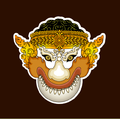Rahu
| Rahu | |
|---|---|
| Member of Navagraha | |
 | |
| Devanagari | राहु |
| Sanskrit transliteration | rāhu (The point of intersection of ascending node of lunar orbit with the elliptic plane of earth's orbit) |
| Affiliation | Graha, Asura,[1] Svarbhanu |
| Abode | Rāhu Kāla |
| Mantra | Om Viprachitti putra Simhika putra Om Navagraha Rahuya Namah |
| Weapon | Sceptre |
| Day | Friday, Rāhu Kāla |
| Mount | Tiger |
| Festivals | Amavasya or Rāhu Kāla |
| Personal information | |
| Parents |
|
| Siblings | Ketu |
Rāhu (Sanskrit: राहु) (☊) is one of the nine major celestial bodies (navagraha) in Hindu texts. Unlike most of the others, Rahu is a shadow entity, one that causes eclipses and is the king of meteors.[1] Rahu represents the ascension of the moon in its precessional orbit around the earth. Rahu is the north lunar node (ascending) and it along with Ketu is a "shadow planet" that causes eclipses. Rahu has no physical shape. It is an imaginary planet but considering the importance of Rahu in astrology, it has been allocated the status of the planet by Rishis
Rahu is usually paired with Ketu which is also considered to be a shadow planet. The time of day considered to be under the influence of Rahu is called Rāhu kāla and is considered inauspicious.[2]
As per Hindu astrology, Rahu and Ketu have an orbital cycle of 18 years and are always 180 degrees from each other orbitally (as well as in the birth charts). This coincides with the precessional orbit of the moon or the ~18 year rotational cycle of the lunar ascending and descending nodes on the earth's ecliptic plane. This also corresponds to a saros, a period of approximately 223 synodic months (approximately 6585.3211 days, or 18 years, 11 days, 8 hours), that can be used to predict eclipses of the Sun and Moon. Rahu rules the zodiac sign of Aquarius together with Shani.
Astronomically, Rahu and Ketu denote the points of intersection of the paths of the Sun and the Moon as they move on the celestial sphere. Therefore, Rahu and Ketu are respectively called the north and the south lunar nodes. That eclipses occur when the Sun and the Moon are at one of these points gives rise to the understanding of swallowing of the Sun and the Moon by the snake. Rahu is responsible for causing the Eclipse of the Sun.
Legends[]
This section needs expansion. You can help by . (February 2018) |
Rahu is found in the Puranic texts.[3] The tales begin in the "remotest periods of prehistoric time, when the gods and asuras churned the Milk Ocean to extract from it the Amrita, the elixir of immortality."[4] Rāhu was present at that time and overcome with pride. Mohini, the female avatar of Vishnu, started distributing Amrit to the Devtaas. However, one Detya, Svarbhanu, sat in the row of devtaas and drank the Amrit. The Sun God and the Moon God noticed him and they informed Mohini; however, by that time Svarbhanu had already become immortal. Vishnu as Mohini cut off Svarbhanu's head with Sudarshan Chakra. Rahuketu could not die but his head was separated from his body and his head came to be known as Rahu, while his body came to be known as Ketu. Following this event, Rahu and Ketu were given the responsibility to influence the lives of the humans on Earth.[3]
Astrology[]
Since Rahu and Ketu are two opposite lunar nodes, they always appear in diametrically opposite houses in horoscopes.
In Hindu astrology Rahu represents materialism, mischief, fear, dissatisfaction, obsession and confusion. Rahu is also associated with politicians and occult sciences. Like Ketu, Rahu is also an enemy against the sun and moon.[5] It is generally considered as a malefic planet in astrology.
Jyotisha is Hindu astrology, which entails concept of Nakshatra (see also List of Natchathara temples), Navagraha (see also List of Navagraha temples and Saptarishi included in the list of Hindu deities whose dedicated temples are found at various Hindu pilgrimage sites to which Hindus take pilgrimage yatra.
Buddhist culture[]
Rāhu is mentioned explicitly in a pair of scriptures from the Samyutta Nikaya of the Pali Canon. In the Candima Sutta and the Suriya Sutta, Rahu attacks Surya, the Sun deity and Chandra, the Moon deity before being compelled to release them by their recitation of a brief stanza conveying their reverence for the Buddha.[6][7] The Buddha responds by enjoining Rāhu to release them, which Rāhu does rather than have his "head split into seven pieces".[7] The verses recited by the two celestial deities and the Buddha have since been incorporated into Buddhist liturgy as protective verses recited by monks as prayers of protection.[8]
Gallery[]

Vishnu beheading Svarbhānu with his Sudarshana chakra
Phra Rahu in Thailand

Rahu iconography in Cambodia
See also[]
- Ketu
- Kirtimukha
- Svarbhanu
- Saros
Notes[]
- ^ a b c d Roshen Dalal (2010). Hinduism: An Alphabetical Guide. Penguin Books. p. 324. ISBN 978-0-14-341421-6.
- ^ Gopal, Madan (1990). K.S. Gautam (ed.). India through the ages. Publication Division, Ministry of Information and Broadcasting, Government of India. p. 77.
- ^ a b Cornelia Dimmitt (2012). Classical Hindu Mythology: A Reader in the Sanskrit Puranas. Temple University Press. pp. 75, 347–349. ISBN 978-1-4399-0464-0.
- ^ Heinrich Zimmer, Myth and Symbols in Indian Art and Civilisation. New York: Harper Torchbooks, 1946, p. 176
- ^ https://internetlk.com/rahu-kalaya/
- ^ Candima Sutta
- ^ a b Suriya Sutta
- ^ to Insight; see the summary in the Devaputta-samyutta section
External links[]
 Media related to Rahu at Wikimedia Commons
Media related to Rahu at Wikimedia Commons
- Asura
- Danavas
- Navagraha
- Planetary deities
- Sun myths
- Moon myths
- Eclipses
- History of astrology
- Deities
- Dharmapalas



